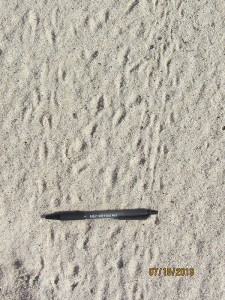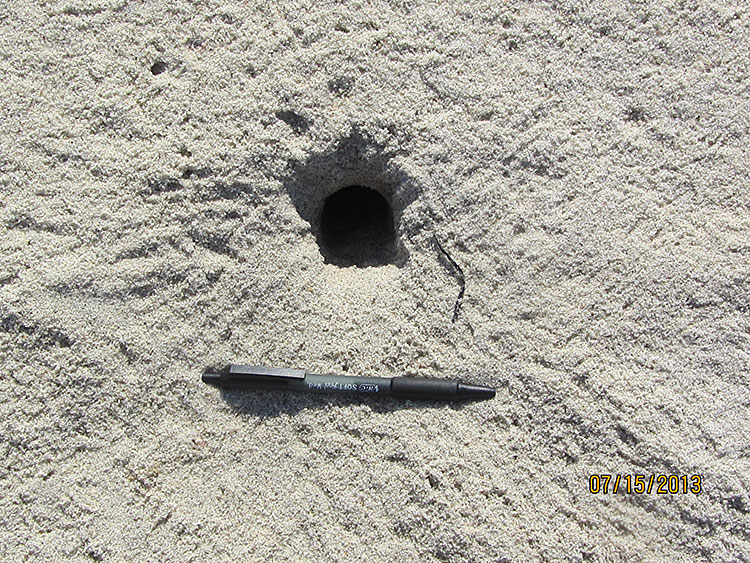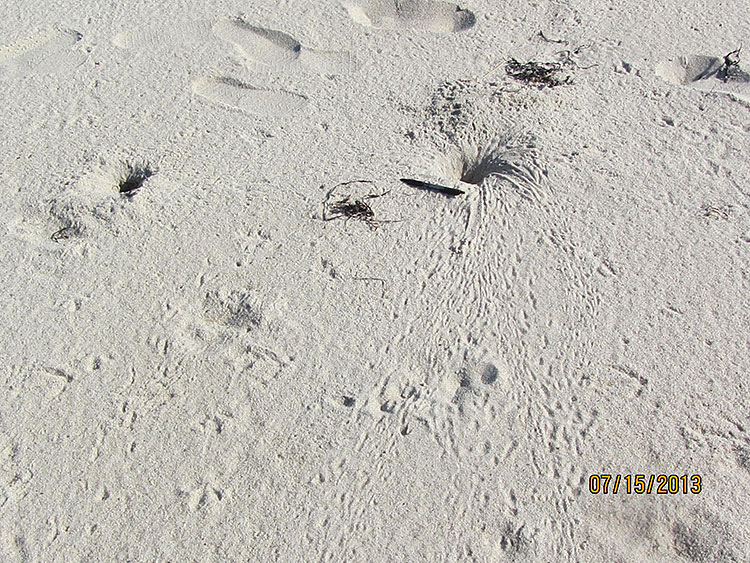• by Dr. Sarah D. Oktay, Managing Director UMass Boston Nantucket Field Station •
The name of this week’s article sounds like an awesome indie horror film doesn’t it? Well ghost crabs are here and probably here to stay on Nantucket. Thanks to the eagle eyes of Manomet Center for Conservation Studies shorebird monitor (and one of my favorite people) Edie Ray, ghost crab holes and tracks have been found at Smith’s Point, and I think it’s time to throw a party and welcome them. Her pictures are included in this article with a “Bic” type in the photos for a size comparison. So what is a ghost crab? How might they change the beach habitat that they share with mole crabs and sand fleas? What does their recent appearance mean?
Ghost crabs, also called sand crabs, are crabs of the genus Ocypode, which can be found all over the world in subtropical and tropical areas. Male ghost crabs are slightly larger overall and they have one claw that is bigger than the other claw, but this difference is not as noticeable as it is in male fiddler crabs (who sometimes have humongous claws for their size). This trait is called sexual dimorphism. Worldwide, there are roughly 20 species of ghost crabs, but Ocypode quadrata is the only one found on the east coast of the United States. The species is a small sand-colored or grayish-white crab, measuring at most a little over 5 cm (2 inches) across the back at maturity. Atlantic Ghost Crabs have squarish sand-colored shells having margins (edges) that are finely beaded but toothless; the claws are white. The space between the eyes is much shorter than the eyestalks. They really look pretty comical almost like a cartoon crab (a picture of them is found here at the Encyclopedia of Life website: http://eol.org/pages/313161/details). Ghost crabs are some of the most terrestrially adapted of crabs, they only have to have access to salt water for two things: females release their eggs at the water’s edge (larvae are aquatic) and they moisten their gills either in the surf or from wet sand. Ghost grabs belong to the Order “Decapoda” which means ten legged. I bet when you have looked at a crab you haven’t thought, look at all those legs?! That’s because some of these appendages have been adapted into mouthparts and claws.
The name ghost crab alludes to their pale ghostly color, daytime elusiveness, and their penchant for nighttime activity (nocturnal creatures). The scientific name Ocypode is derived from the Greek roots “ocy-“ meaning “fast” and “podos” for “foot”, in reference to the animal’s speed. And they are indeed super fast. They can run up to 10 miles an hour and change course on a dime. When I lived in Galveston and would walk the beach at night, you would see virtual armies of these guys popping in and out of holes. The species name comes from the Latin “quadratus” for “square” referring to their squarish carapace or body. The ghost crabs come out at night to feed (sounds like a zombie movie doesn’t it?) to avoid predation by shorebirds like gulls.
David Knott, writing for the South Carolina Department of Natural Resources where they are much more common tells us more about the Atlantic Ghost Crab: “In 1787, J.C. Fabricius formally described the Atlantic ghost crab from specimens collected in Jamaica, originally calling it Cancer quadrata. Following Linnaeus’ development of the modern scientific method of naming organisms, the name ‘Cancer’ was commonly applied to a variety of crustacean taxa, not just crabs, by taxonomists and carcinologists [people who study crustaceans]. Ocypode quadrata, also known for some time as O. albicans or the “fleet-footed one of white,” was characterized by Phillips (1940) as “an occult, secretive alien from the ancient depths of the sea.” Since the time he wrote that romanticized description, much has been learned about this conspicuous inhabitant of the ocean beach community.” http://www.dnr.sc.gov/cwcs/pdf/Ghostcrab.pdf retrieved July 28th, 2013.

Their stalked compound eyes can swivel to give them 360° vision. Young crabs are cryptically colored to blend in with their sandy habitat. The young crabs build their holes closer to the water while older crabs build theirs further away from the high tide line, sometimes as far as a quarter mile from the tide line. The burrow down as far as 4 feet and can close the top of their burrows with sand when it is very hot or very cold. Their gills allow them to carry of pillow of oxygen close to their body which they will use to sustain themselves when they hibernate over the winter. Juvenile and females make their holes pretty sloppily, but adult males will make a nice pile of sand balls very similar to the pseudo feces that fiddler crabs adorn their hole entrances with (look honey, I am a great mate, my lawn is so organized!). Adult ghost crabs dig deep burrows, comprising a long shaft with a chamber at the end, occasionally with a second entrance shaft. They remain in the burrow during the hottest part of the day, and throughout the coldest part of the winter. According to Wayne and Martha McAlister’s “Life on Matagorda Island” (Texas A&M University Press, 2004) “Ghost Crab tunnels enter the sand at 45° angles and are directed so that they catch the onshore breeze. Often two tunnels join into a Y, possibly to create a draft through the lair. Other tunnels are simple Ls or Js, the bottoms enlarged so that the crab can rest and turn around during the day when normally it’s belowground. The tunnels descend to just above the water table, and usually there’s just one crab per tunnel” [from http://books.google.com/books/about/Life_on_Matagorda_Island.html?id=rOkCqL4rrHoC accessed July 29th 2013).
Ghost crabs, in keeping with their names, emerge mostly at night, to feed on mole crabs (Emerita talpoida), clams, and other beach crustaceans. They are omnivores who will eat a wide range of items, including carrion, plant material, debris and occasionally turtle hatchlings further south. Their presence indicates that a beach is in good health. O. quadrata can produce a variety of sounds, by striking the ground with the claw, by stridulation with the legs (more about that below), and sometimes emitting an incompletely explained “bubbling sound”. Some people say they can also hear their digging noises underground from as far as six feet away.
Ghost crabs have a ritualized competition for a female ghost crab’s affections, which involves a choreographed fight between two males, raising both their claws as well as their bodies in intimidating poses until one sinks into a submissive posture and gives in. If this doesn’t happen right away, a “pushing fight” ensues until one crab finally withdraws. All this hullaballoo happens at night. Ghost crabs have a unique mechanism on its right claw known as a stridulating organ. When it strokes this against the bottom of its leg, a squeaky noise is produced. A crab produces this noise to warn other crabs not to enter its burrow. Male crabs also use this sound to attract female mates so they can have something to fight over. Usually, crabs tend to reproduce continuously in tropical and subtropical regions, because of the favorable environmental conditions for availability of food, development of gonads, and liberation of larvae, whereas in temperate zones reproduction is restricted to the warm months. The females release their eggs in the surf zone (if held underwater ghost crabs suffocate so this is more dangerous than it looks). The larvae take about six weeks to develop in the ocean currents before they wash back ashore.
It appears that scientist are just now starting to undertake more serious population surveys of the creatures further south on the Atlantic coast where they are more common. As ghost crabs move north they will likely replace sand-hoppers which are the more dominant beach organisms in cooler areas like New England. It is somewhat hard to find out what eats ghost crabs; in some locations, hawks, shorebirds and gulls are their primary predator. Scientist found that ghost crabs were a significant part of the diet of the burrowing owl Athene cunicularia in Brazil http://www.avesmarinhas.com.br/Bioecoloy%20of%20the%20ghost%20crab%20Ocypode%20quadrata.pdf retrieved July 28 2013. Their nocturnal habits are thought to be their way of avoiding becoming a snack for shorebirds.
From http://biodiversityworksmv.org/atlantic-ghost-crabs-on-marthas-vineyard/ (accessed July 28th 2013) we learn that ghost crabs have been seen on and off on Martha’s’ Vineyard for years in spite of being listed as only appearing as far north as Long Island. The aquatic larvae probably washed up on our southern shores from eddies and other offshoots of the Gulf Stream.
Luanne Johnson, a Martha’s Vineyard biologist completing her PhD with Antioch University and the Director of the nonprofit organization BiodiversityWorks has been tracking these for the several years on our sister island. Other MV associated biologists such as Dr. Tim Simmons, with the Massachusetts Natural Heritage program saw small ones on Martha’s Vineyard back in the 1980s but has been noticing them getting bigger and bigger. And island naturalist, former director of the Felix Neck Wildlife Sanctuary, and current owner of the World of Reptiles in Edgartown, Gus Ben David, has seen them for close to 40 years. Whether this is an offshoot of climate change or simply a normal extension of range, it is a bit early to tell. One thing that may be worrisome to scientists on both islands is the predilection of these crabs to eat plover eggs and chase chicks. The last thing piping plovers need is an additional predator that they don’t expect (something like the Spanish Inquisition!) To read more about their introduction to Martha ’s Vineyard and how island scientists have kept tabs on them go to http://mvgazette.com/news/2012/05/31/ghost-crab-arrivals-may-signal-climate-shift-threaten-plovers.
In a recent study conducted in North Carolina, Peterson et al. (2000) found significant deleterious effects on ghost crab populations resulting from beach nourishment and bulldozing on eroding beaches. In addition to these practices, the loss of intertidal; beaches to shorefront armoring was also considered primary threats to the well being of ghost crab populations in South Carolina. Not only does this compromise the ghost crabs themselves, but these activities wipe out their primary food sources.
The large burrows Edie found and that have been found on the Vineyard indicate that these bad Larrys overwinter on island. That is pretty amazing considering how tough this last winter has been. We can help keep track of the burrows and their extension in the Cape by emailing their coordinates to Ms. Johnson at biodiversityworks@gmail.com with your name, date, and location. Place a coin or another object near it for reference and take a photo like the ones in this article from Edie Ray. Learn more about her work at http://biodiversityworksmv.org/atlantic-ghost-crabs-on-marthas-vineyard/. And next time you are at the beach listen for their digging or look for their holes and imagine their nightly marches.
More resources:
Branco, J., J. Hillesheim, H. Fracasso, M. Christoffersen, C. Evangelista. 2010. Bioecology of the ghost crab Ocypode quadrata (Fabricius, 1787) (Crustacea: Brachyura) compared with other intertidal crabs in the Southwestern Atlantic. Journal of Shellfish Research, 29 (2): 503-512. At http://www.avesmarinhas.com.br/Bioecoloy%20of%20the%20ghost%20crab%20Ocypode%20quadrata.pdf retrieved July 28 2013.
Peterson, C.H., D.H.M. Hickerson and G.G. Johnson. 2000. Short-term consequences of nourishment and bulldozing on the dominant large invertebrates of a sandy beach. Journal of Coastal Research. 16:368-378.




